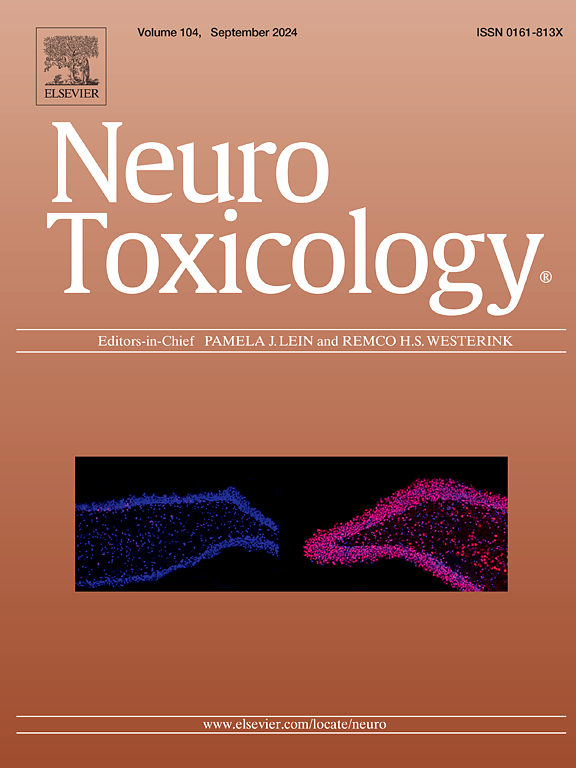载胸腺醌的固体脂质纳米颗粒通过调节PGC-1α/Nrf2通路减轻3-硝基丙酸诱导的线粒体功能障碍和氧化损伤
IF 3.9
3区 医学
Q2 NEUROSCIENCES
引用次数: 0
摘要
3-硝基丙酸(3-NP)是一种线粒体毒素,在实验动物中引起双侧纹状体损伤,模拟亨廷顿病(HD)病理。3- np诱导的神经元死亡的分子机制包括线粒体功能障碍、转录失调和抗氧化防御系统受损。本研究探讨了固体脂质纳米颗粒(NanoTQ)包封的百里醌(TQ)对3- np诱导的雄性Wistar大鼠纹状体线粒体生物发生的影响。全身给药3-NP(10 mg/kg) 14天可抑制线粒体复合体酶,增加纹状体线粒体膜通透性。3-NP暴露通过改变p-CREB/TORC1/SIRT1/PPARγ的表达显著改变PGC-1α的翻译水平。此外,3-NP暴露显著降低纹状体BDNF、GDNF及其下游效应物的水平。与TQ(40 mg/kg)相比,nanoq(10和20 mg/kg)和TQ(80 mg/kg)显著提高了线粒体复合体酶活性(P <; 0.01)。NanoTQ还显著(P <; 0.01)调节调节蛋白的表达,促进PGC-1α介导的线粒体生物发生。此外,NanoTQ通过增加纹状体中Nrf-2和HO-1的表达,降低Keap1水平,恢复BDNF和GDNF信号通路,增强抗氧化防御机制。综上所述,NanoTQ通过调节线粒体生物发生、神经营养因子和抗氧化防御系统,有效减轻3- np诱导的神经毒性,从而预防大鼠hd样症状。本文章由计算机程序翻译,如有差异,请以英文原文为准。
Thymoquinone-loaded solid lipid nanoparticles mitigate 3-Nitropropionic acid-induced mitochondrial dysfunction and oxidative damage via regulating PGC-1α/Nrf2 pathway
3-Nitropropionic acid (3-NP) is a mitochondrial toxin which causes bilateral striatal lesions in experimental animals, mimicking Huntington’s disease (HD) pathology. The molecular mechanisms underlying 3-NP-induced neuronal death involve mitochondrial dysfunction, transcriptional dysregulation, and impaired antioxidant defense systems. This study investigated the effects of thymoquinone (TQ) encapsulated in solid lipid nanoparticles (NanoTQ), on mitochondrial biogenesis in 3-NP-induced neurotoxicity in the striatum of male Wistar rats. Systemic administration of 3-NP (10 mg/kg) for 14 days inhibited mitochondrial complex enzymes and increased mitochondrial membrane permeability in the striatum. 3-NP exposure significantly altered the translational level of PGC-1α by modifying the expression of p-CREB/TORC1/SIRT1/PPARγ. Additionally, 3-NP exposure significantly reduced striatal levels of BDNF, GDNF, and their downstream effectors. Treatment with NanoTQ (10 and 20 mg/kg) and TQ (80 mg/kg) significantly (P < 0.01) increased mitochondrial complex enzyme activity compared to TQ (40 mg/kg). NanoTQ also significantly (P < 0.01) regulated the expression of regulatory proteins, promoting PGC-1α mediated mitochondrial biogenesis. Furthermore, NanoTQ restored BDNF and GDNF signaling and enhanced the antioxidant defense mechanism by increasing Nrf-2 and HO-1 expression while reducing Keap1 levels in the striatum. In conclusion, NanoTQ effectively mitigated 3-NP-induced neurotoxicity by regulating the mitochondrial biogenesis, neurotrophic factors, and antioxidant defense system, thereby preventing HD-like symptoms in rats.
求助全文
通过发布文献求助,成功后即可免费获取论文全文。
去求助
来源期刊

Neurotoxicology
医学-毒理学
CiteScore
6.80
自引率
5.90%
发文量
161
审稿时长
70 days
期刊介绍:
NeuroToxicology specializes in publishing the best peer-reviewed original research papers dealing with the effects of toxic substances on the nervous system of humans and experimental animals of all ages. The Journal emphasizes papers dealing with the neurotoxic effects of environmentally significant chemical hazards, manufactured drugs and naturally occurring compounds.
 求助内容:
求助内容: 应助结果提醒方式:
应助结果提醒方式:


